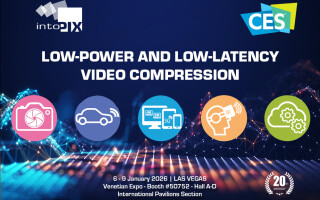Handle Capacitive, Inductive, and Liquid Sensing With a Single PSOC Device
April 14, 2025
Sponsored Story

The ability to “sense” in different modalities is known as multi-sensing. In a perfect world, that multi-sensing capability would be integrated into a single MCU. And thanks to the Infineon PSOC 4 Multi-Sense MCUs, the perfect world has ascended upon us. But more about that specific device in a bit.
Instead of relying on discrete sensors or a solution using multiple ICs, a PSOC 4 multi-sense device can do it all, including capacitive, inductive, hover touch, and liquid sensing. For background, capacitive sensing is commonly used on modern touchscreens, touch-button and proximity-sensing designs to detect human and machine interactions. Capacitive sensing works by detecting capacitance, an electrical property, caused by the presence of a conductive element or a human body on or in close proximity to the sensor. Infineon’s PSOC 4 Multi-Sense extends the same technology to reliably measure humidity or sense liquid levels.
Principles of Inductive Sensing
Inductive sensing relies on electromagnetic fields to detect the presence of metallic objects. When a conductive object, such as metal, enters this field or come closer to the sensor, eddy currents are induced on its surface. These eddy currents create an opposing magnetic field, which alters the original field generated by the sensor coil. The PSOC 4 Multi-Sense interprets these variations to determine the object's presence, distance, or material properties. The strength of the interaction depends on factors like object conductivity, size, and distance from the coil. This change in inductance is detected and processed by the PSOC 4 Multi-Sense circuitry.

These sensors are highly durable and work well in harsh environments where other sensors might fail. Use cases include anyplace where touch-sensing UIs are needed on metal surfaces, such as refrigerator front panels or products whose touch-sensing UI must work in the presence of excessive liquids. Such products include tooth brushes, shavers, or products that operate underwater, like dive cameras. And there are a host of use cases in the industrial automation and position-sensing sectors.
Liquid Sensing
Liquid sensing involves detecting the presence, level, flow, or composition of a liquid using various technologies, depending on the application. The most common methods include capacitive, ultrasonic, optical, and conductive sensing.
Infineon’s liquid-sensing solution, based on Multi-Sense, is a non-invasive, non-contact liquid sensing technique that makes use of a proprietary sensing method and an AI/ML algorithm to facilitate cost-effective and accurate sensing. The combination of proprietary sensing coupled with an AI/ML processing engine brings unique advantages. For example, the sensor can differentiate between water and soap foam to accurately and separately indicate the levels of water and foam that are on top of the water, and it can adjust to any size and/or container shape. Overall, AI/ML simplifies the design cycle and learning curve for system designers. And it’s resistant to environmental factors like temperature and humidity.
Integrating all three of these technologies into one device can result in versatile, efficient, and cost-effective smart sensing solutions. Let’s quickly run through the benefits of the integrated technology:
- Multi-modal sensing for accuracy and reliability – Different sensing methods compensate for each other’s weaknesses. For example, capacitive sensing is best suited for detecting touch on non-conductive surfaces, but struggles with metal objects, which is the sweet spot for inductive sensing.
- Reduced system complexity and cost – Integrating multiple sensing technologies into one MCU eliminates the need for separate sensors and controllers, reducing component count, power consumption, and manufacturing costs.
- Suitability for an array of industrial and consumer applications – This could include industrial automation, home appliances (such as white goods), and even medical devices.
- Space optimization – One device can replace multiple discrete components
The PSOC 4000T and PSOC 4100T Plus extend Infineon’s PSOC 4 product family of Arm Cortex-M0+ based MCUs that boast advanced HMI capabilities. Multi-Sense is the sensing component that differentiates the PSOC 4000T and PSOC 4100T Plus, transforming them into a comprehensive sensing solution that integrates Infineon's 5th Generation CAPSENSE, inductive, hover-touch, and liquid-level sensing.

Let’s dive into some of the details of Infineon’s latest PSOC MCU, the 4000T. It’s a best-in-class low-power sensing solution with exceptional signal-to-noise ratio (SNR), liquid tolerance, and multi-sense capabilities coupled with enhanced reliability and robustness based on new radiometric and differential sensing architecture.
Infineon’s PSOC 4100T Plus, on the other hand, offers the same Multi-Sense functionality as PSOC 4000T but with more GPIO, Sensors, Memory, and peripherals, making the ideal for single-chip HMI and system controls implementation.
The device’s inductive sensing feature is based on a flyback sensing architecture, providing vast flexibility on both the sensor’s inductance and its operating frequency. Additionally, the MCU’s liquid-level sensing eliminates the need for direct contact with the liquid being sensed/measured. It operates flawlessly in noisy environments and can detect different liquids and reject foam and residue.
Easy Migration Path
And if you’re familiar with the previous generations of the PSOC 4 family, including the PSOC 4000 and 4000S, you have an easy upgrade path to higher levels of functionality, thanks to software and package compatibility.
Developers can design intuitive and flexible solutions for sensor-based applications by combining Infineon's PSOC 4 Multi-Sense device with the Sensor Designer Tools in the ModusToolbox offering. The tools provide a graphical user interface and pre-configured sensor libraries, enabling quick setup, tuning, and real-time debugging without extensive coding.
Integrated auto-tuning algorithms help optimize performance across various environments, while seamless integration with ModusToolbox facilitates rapid prototyping and cross-platform development. This combination enhances ease of use by simplifying sensor calibration and implementation, allowing engineers to focus on innovation rather than low-level firmware development.
The bottom line is that the PSOC 4 Multi-Sense MCUs enable new use cases, save time and money with integration, while maximizing the user experience. Its benefits translate to a competitive edge for OEMs by enabling high-performance, low-power HMI designs. Contact Infineon for more information.





